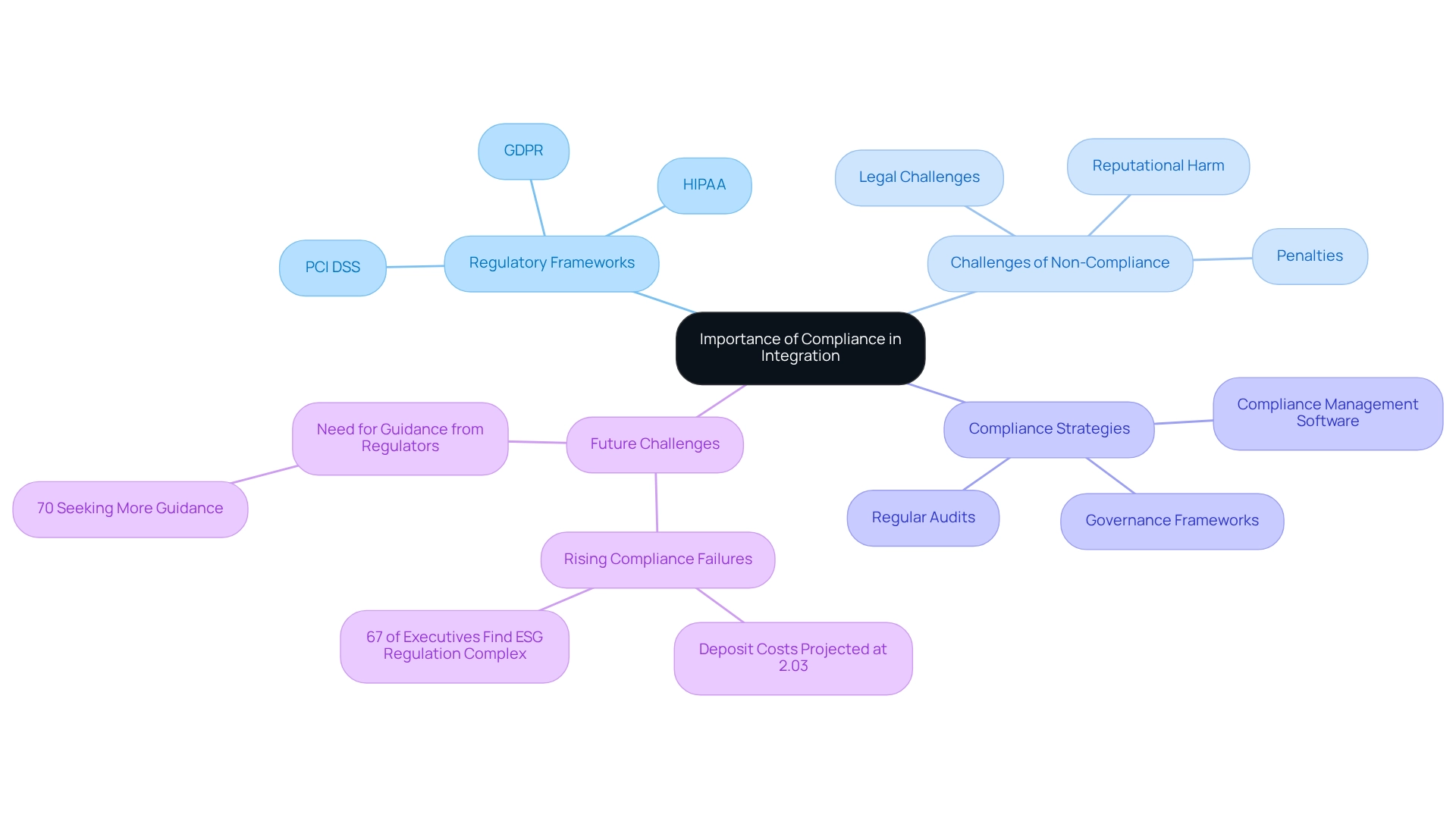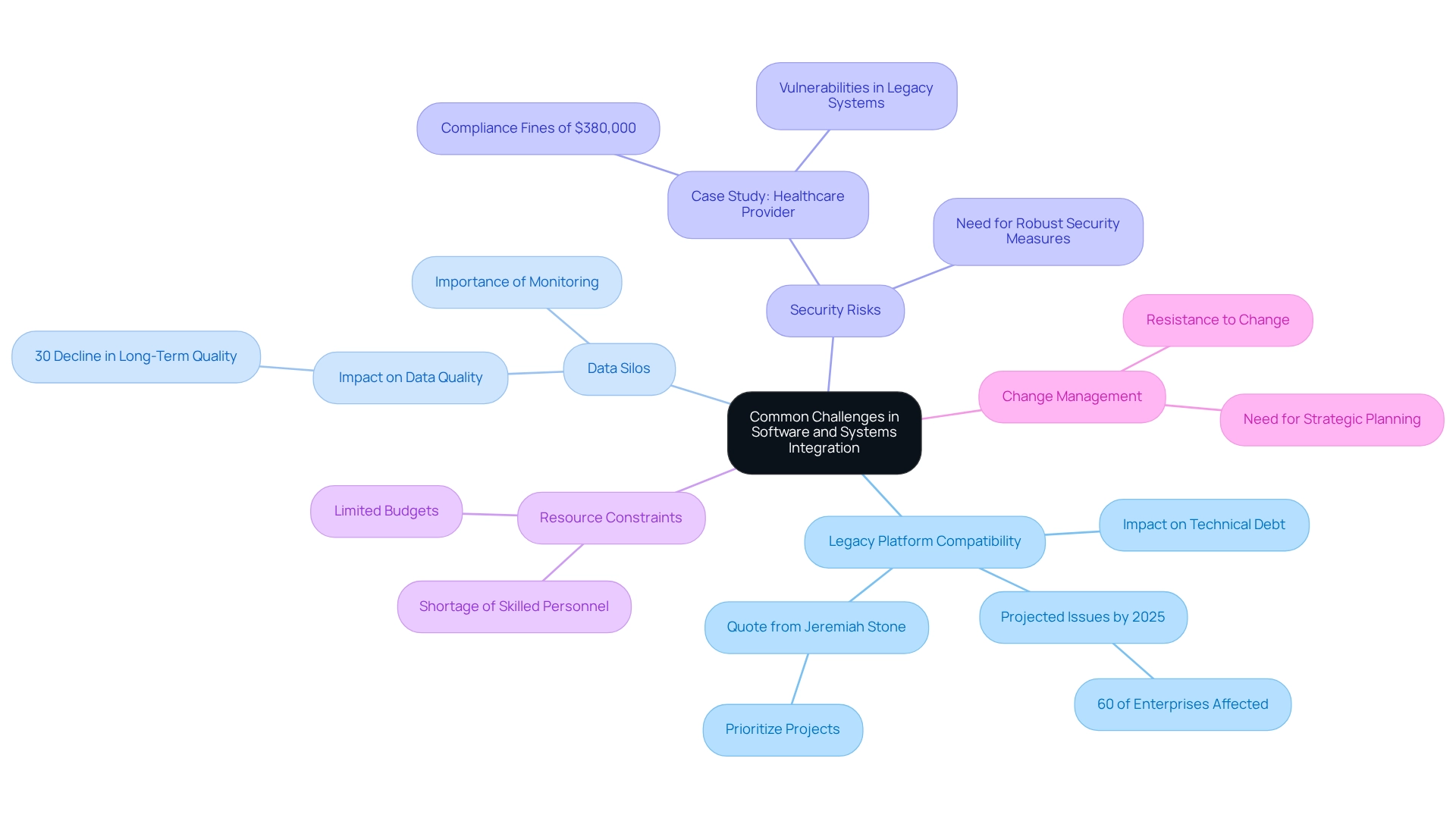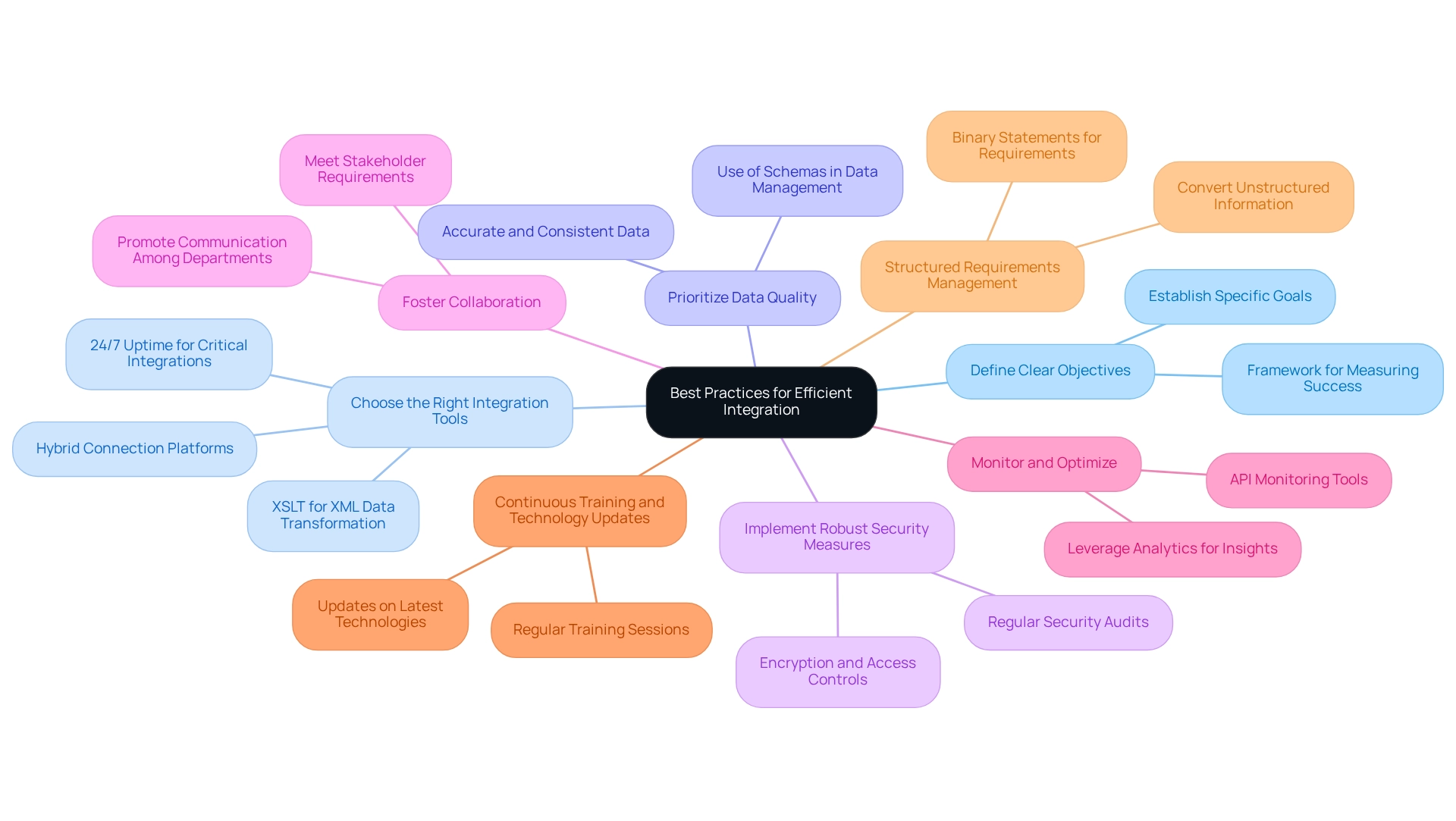Overview
Best practices for software and systems integration are essential for enhancing compliance and efficiency through clear objectives, robust tools, and real-time monitoring. Organizations face significant operational challenges; however, by adopting these strategies, they can dramatically improve effectiveness and navigate regulatory hurdles. Successful case studies illustrate this point, showcasing the growing reliance on hybrid integration platforms like Avato’s. As a result, companies are empowered to achieve their goals more effectively than ever before.
Introduction
In today’s interconnected digital landscape, the integration of diverse software applications and systems is essential for organizational success. Companies are increasingly focused on enhancing efficiency and streamlining operations, yet the complexities of software and systems integration present both significant challenges and unique opportunities.
With many businesses contending with legacy systems and data silos, the need for effective integration strategies is more urgent than ever. This article explores the critical aspects of software and systems integration, examining best practices, compliance considerations, and the transformative potential of hybrid integration platforms like Avato’s.
By understanding key trends and challenges, organizations can confidently navigate the integration landscape, positioning themselves for future growth and innovation.
Understanding Software and Systems Integration
The process of linking different software programs to operate as a cohesive whole is known as software and systems integration with various applications. This unification is essential for organizations striving to enhance efficiency, eliminate operational silos, and optimize data flow across multiple platforms. Effective software and systems integration allows different systems to interact, exchange information, and automate processes, which promotes better decision-making and boosts operational flexibility.
In 2025, the importance of combining systems has only increased, with over 40% of companies recognizing application unification as a top challenge, as highlighted in the Mulesoft & Deloitte 2022 report. This emphasizes the necessity for businesses to adopt robust unification strategies through software and systems integration to navigate the complexities of their digital environments. Avato’s hybrid unification platform is crafted to tackle these challenges efficiently, equipping businesses with the resources required for software and systems integration to connect isolated legacy systems and fragmented data smoothly, thereby enhancing and prolonging the worth of these legacy systems.
Recent trends suggest that organizations are progressively allocating resources to unification solutions to enhance sales close rates, which serves as the main incentive for numerous companies. For instance, Typeform users who utilize Zapier connections experience a 40% lower churn rate, demonstrating the tangible advantages of seamless software connectivity. This trend is especially significant for the banking sector, where operational efficiency is essential, and the platform plays a critical role in connecting legacy systems with contemporary expectations.
Successful examples of collaboration abound, with entities such as OSME Pacific and BC Provincial Health Services Authority commending the company for its capacity to streamline intricate project implementations and achieve outcomes within specified time limits and budgetary restrictions. John Johnstone from OSME Pacific observed how the platform facilitated rapid attainment of connectivity objectives, while Gustavo Estrada from BC Provincial Health Services Authority highlighted the effectiveness achieved through the company’s solutions. These testimonials underscore how the company has strengthened its worth in the market by enabling entities to reach their connection objectives swiftly and effectively, unlocking data and platforms in weeks with 12 levels of interface maturity.
Furthermore, Avato’s hybrid unification platform provides real-time monitoring and notifications on system performance, ensuring that organizations can proactively manage their software and systems integration and respond to issues as they arise. As companies continue adjusting to changing demands, the influence of software and systems integration on operational agility becomes increasingly evident. Sarah Lee aptly stated, “Let us embrace this momentum and look forward with the conviction that the best is yet to come,” reflecting the optimistic outlook on the role of unification in driving future growth.
By adopting best practices for combining processes, organizations can not only improve their operational efficiency but also prepare themselves for future growth and innovation, all while significantly lowering expenses.
The Importance of Compliance in Integration
Compliance stands as a crucial pillar in software and systems integration, particularly within sectors such as banking, healthcare, and government, where regulatory frameworks are stringent. Organizations face the challenge of navigating complex regulations, including GDPR, HIPAA, and PCI DSS, to ensure their assimilation processes meet legal standards. The stakes are high; non-compliance can lead to substantial penalties, legal challenges, and reputational harm.
To effectively uphold compliance, entities must establish robust governance frameworks that guide their integration efforts. Regular audits are essential for identifying potential compliance gaps, while software and systems integration can streamline adherence to regulations through the use of compliance management software that integrates seamlessly with existing systems. This proactive strategy not only mitigates risks but also fosters trust among stakeholders and customers, reinforcing the entity’s commitment to ethical practices.
As we look toward 2025, the landscape of compliance challenges is evolving. Statistics indicate that compliance failures in banking and healthcare are on the rise. For instance, deposit costs are projected to reach 2.03%, significantly higher than the previous five-year average of 0.9%. This underscores the urgency for entities to prioritize adherence in their unification processes, as the financial consequences can be significant.
Case studies reveal that entities successfully achieving compliance in their unification efforts often leverage advanced technologies and methodologies related to software and systems integration. Regulatory specialists emphasize the importance of understanding the impacts of GDPR and HIPAA on merging processes, noting that failure to adapt can hinder operational effectiveness and expose entities to regulatory scrutiny. Gustavo Estrada highlights the company’s ability to streamline complex projects and achieve outcomes within specified timelines and financial constraints, demonstrating how efficient coordination can bolster compliance initiatives.
The company’s expert connection services ensure that businesses have access to skilled partners who can assist in navigating these challenges, optimizing connection strategies, and future-proofing systems. Furthermore, with 67% of global executives finding ESG regulation overly complex, organizations face significant hurdles in maintaining compliance. By prioritizing compliance and utilizing a reliable, future-ready technology stack, businesses can not only avoid pitfalls but also enhance their operational capabilities and maintain a competitive edge in their respective industries.
For additional details on how Avato can assist with implementation expenses, timelines, and project recovery, please contact our team.

Common Challenges in Software and Systems Integration
Organizations frequently face numerous challenges during software and systems integration, significantly impacting their operational efficiency and decision-making capabilities. Key challenges include:
-
Legacy Platform Compatibility: Many businesses still rely on outdated technologies that struggle to integrate with modern applications, resulting in increased technical debt and operational inefficiencies. By 2025, it is projected that over 60% of enterprises will continue to grapple with legacy compatibility issues, underscoring the urgent need for modernization.
As Jeremiah Stone, CTO of SnapLogic, emphasizes, “Executives should prioritize projects that reduce technical debt, create new revenue streams, or democratize technologies.” The platform plays a crucial role in transforming outdated systems, enabling organizations to streamline complex connections and provide cost-effective solutions.
-
Data Silos: The existence of disparate data sources often leads to inconsistencies that obstruct effective decision-making. Organizations that neglect to address data silos may suffer a 30% decline in long-term data quality, making it increasingly vital to monitor data post-migration with predefined metrics. Avato’s hybrid unification platform accelerates the connection of isolated networks, delivering the integrated foundation businesses need to modernize.
-
Security Risks: The merging of networks can reveal vulnerabilities, necessitating the implementation of robust security measures. A notable case involved a healthcare provider that incurred $380,000 in compliance fines due to critical vulnerabilities in their legacy patient database, highlighting the severe repercussions of outdated technologies on security and compliance. Avato’s platform is engineered for secure transactions, ensuring that organizations can integrate systems without compromising security.
-
Resource Constraints: Limited budgets and a shortage of skilled personnel can significantly impede unification efforts, making it essential for companies to prioritize projects that enhance resource efficiency.
-
Change Management: Resistance to change within organizations can obstruct assimilation processes, necessitating a strategic approach that incorporates thorough planning and stakeholder engagement.
To overcome these challenges, organizations must leverage advanced unification technologies that guarantee 24/7 availability for vital connections and support 12 levels of interface maturity, striking a balance between speed and sophistication in unification efforts. By implementing optimal strategies and utilizing Avato’s features, organizations can facilitate seamless integration while ensuring compliance and operational effectiveness.

Best Practices for Efficient Integration
To attain effective software and systems unification, companies must consider the following best practices:
-
Define Clear Objectives: Establishing specific goals for unification projects is crucial. Clear objectives not only align efforts but also provide a framework for measuring success, ultimately leading to better project outcomes.
-
Choose the Right Integration Tools: Selecting appropriate tools tailored to the organization’s needs is essential. Hybrid connection platforms, like Avato’s, can effortlessly link cloud and on-site systems, enabling a more unified connection process. Avato ensures 24/7 uptime for critical integrations, highlighting the reliability aspect of integration tools. Moreover, leveraging XSLT for XML data transformation can significantly enhance the efficiency of data handling, allowing organizations to express and manipulate data in innovative ways.
-
Prioritize Data Quality: Ensuring that data is accurate, consistent, and accessible across integrated platforms is vital for effective decision-making. High-quality data enhances the reliability of insights derived from integrated systems, thereby improving overall operational efficiency. The use of schemas in data management not only streamlines this process but also reduces costs by minimizing programming errors and ensuring compliance with industry standards.
-
Implement Robust Security Measures: Safeguarding sensitive data during incorporation is paramount. Employing encryption, access controls, and conducting regular security audits can protect information and maintain compliance with industry regulations.
-
Foster Collaboration: Promoting communication and cooperation among departments guarantees that unification efforts meet the requirements of all stakeholders. This cooperative method can result in more successful merging outcomes and enhanced user satisfaction.
-
Monitor and Optimize: Ongoing observation of performance in the system is essential to pinpoint areas for enhancement. Organizations should leverage tools for API monitoring to evaluate performance from various perspectives, allowing for timely adjustments that enhance efficiency and compliance. Employing analytics can offer insights into system performance, allowing proactive management of processes.
-
Continuous Training and Technology Updates: Regular training and updates are essential for optimizing integrated systems. Keeping teams updated on the latest technologies and practices ensures that collaborative efforts remain effective and aligned with organizational goals.
-
Structured Requirements Management: As a digital transformation architect or analyst, converting unstructured information into a structured form is crucial. This involves breaking down requirements into simple binary statements, ensuring that each requirement can be tested for compliance. This organized method improves clarity and efficiency in project collaborations.
Including these best practices can greatly influence the success of collaborative projects. For instance, firms that establish clear goals and employ successful promotion tactics, like in-app notifications (utilized by 56% of firms), have experienced a significant rise in visibility and uptake of their offerings. As emphasized by industry expert Jon Gitlin, providing connections with applications can be essential for gaining traction in target markets.
By following these guidelines, companies can manage the intricacies of software and systems integration with increased assurance and achievement.
Obtain your copy now to discover how this service can help you optimize your connection processes.

Leveraging Hybrid Integration Platforms for Success
Hybrid connection platforms (Hips) provide a robust solution for organizations aiming to integrate software and systems, unifying diverse structures and applications. Avato’s dedicated hybrid integration platform exemplifies this by enabling seamless connectivity between on-premises and cloud-based systems, allowing businesses to leverage the strengths of both environments. The name ‘Avato,’ derived from the Hungarian word for ‘of dedication,’ reflects the company’s commitment to architecting the technological foundation necessary for delivering rich, connected customer experiences.
The key benefits of utilizing Avato’s HIP include:
- Flexibility: Organizations can choose the most suitable tools and technologies tailored to their specific needs, avoiding vendor lock-in and fostering innovation.
- Scalability: The HIP is designed to scale effortlessly, accommodating increasing data volumes and user demands—crucial as businesses expand.
- Faster Time to Market: By simplifying connection processes, the company enables organizations to launch new applications and services swiftly, enhancing their competitive edge in a rapidly evolving market.
- Cost Efficiency: Streamlining connections reduces operational complexities, leading to lower expenses and improved resource utilization. This is particularly advantageous in sectors like banking, where budget constraints are prevalent. As Gustavo Estrada, a client, noted, “The platform simplifies intricate projects and delivers results within preferred timelines and financial limits,” illustrating how software and systems integration enhances the efficiency of hybrid approaches in achieving strategic objectives.
- Enhanced Security: Many HIPs, including Avato’s, incorporate advanced security features that safeguard sensitive data during the integration process, addressing the critical need for compliance in regulated industries.
The market for hybrid connection platforms is poised for significant growth, with the Asia-Pacific region expected to experience the highest compound annual growth rate (CAGR) of 20.12% from 2024 to 2032, driven by industrialization and escalating digital transformation efforts. In 2024, North America emerged as the largest market for platform as a service (iPaaS), underscoring the increasing demand for real-time data unification and the integration of AI and machine learning capabilities.
Entities utilizing HIP, supported by a team of specialists, have reported substantial improvements in scalability and adaptability. For instance, firms in the banking sector have effectively leveraged HIP to enhance their operational capabilities, enabling them to respond more efficiently to market changes and client needs.
In conclusion, adopting Avato’s hybrid connection approach not only streamlines collaboration efforts but also accelerates digital transformation initiatives, positioning Hips as a vital component for organizations striving to excel in today’s competitive landscape through effective software and systems integration.
Real-Time Monitoring: A Key to Compliance and Efficiency
Real-time monitoring stands as a cornerstone for ensuring compliance and operational efficiency in software and systems integration. By consistently monitoring performance and data flows, organizations can swiftly recognize and resolve issues before they escalate into serious problems. Key aspects of real-time monitoring include:
- Performance Alerts: Establish notifications for any irregularities or performance declines, facilitating prompt corrective actions that can prevent downtime and maintain integrity. Avato guarantees round-the-clock availability for essential connections, underscoring the critical role of these alerts in sustaining operational efficiency and reliability in complex environments, particularly in sectors such as banking, healthcare, and government.
- Audit Trails: Maintain comprehensive logs of all integration activities, essential for supporting compliance audits and investigations, ensuring transparency and accountability.
- Data Integrity Checks: Regularly verify the accuracy and consistency of information exchanged between platforms, crucial for preserving trust in integrated processes and meeting regulatory standards. This is particularly vital for maximizing the value of legacy systems while simplifying complex integrations.
- Automated Reporting: Generate real-time reports that provide stakeholders with insights into performance and compliance status, empowering informed decision-making and proactive management.
Organizations that adopt robust real-time monitoring practices in software and systems integration experience significant enhancements in their efforts, effectively minimizing risks and ensuring adherence to regulatory requirements. As companies prepare for the future amid stricter regulations, the integration of performance alerts with compliance monitoring tools proves essential. This strategy not only bolsters security but also simplifies compliance reporting, enabling businesses to navigate complex regulatory landscapes with confidence.
Gustavo Estrada, a client, praised Avato for its ability to simplify intricate projects and deliver results within preferred timelines and budget constraints, showcasing the effectiveness of efficient integration practices. Moreover, implementing advanced strategies such as AI-driven risk detection tools and real-time compliance monitoring can further enhance governance and risk reduction in software and systems integration efforts. The synergy of Identity and Access Management tools with real-time compliance frameworks exemplifies how software and systems integration can bolster security and facilitate compliance reporting through effective monitoring practices.
By prioritizing real-time monitoring, companies can refine their coordination strategies, ensuring agility and compliance in an ever-evolving environment. Additionally, Avato’s capabilities in reducing costs through streamlined processes and enhanced efficiency further amplify the value of legacy frameworks, establishing it as an indispensable tool for organizations striving to optimize their integration efforts.
The Future of Software and Systems Integration
The future of software and systems integration is on the brink of a remarkable evolution, driven by technological advancements and shifting business demands. Key trends to monitor include:
- AI-Driven Collaboration: The integration of artificial intelligence is increasingly prevalent, automating and optimizing processes to enhance efficiency while minimizing manual intervention. Notably, 58% of business leaders believe that AI will create tailored customer experiences, underscoring its transformative potential in unification. Generative AI has experienced a 60% increase in usage for customer experience within financial services, as institutions develop sophisticated chatbots and virtual assistants. Pavel Nekrasov, AI Group Manager, states, “AI, like any technology, is a tool. When used professionally, it enhances quality and boosts efficiency. For example, in healthcare — one of the most sensitive fields — we help our clients implement solutions that improve operational quality, reduce time and costs, and ultimately enhance patient recovery.” This highlights the essential role AI plays in achieving success in unification.
- No-Code and Low-Code Solutions: The rise of no-code and low-code platforms empowers non-technical users to create connections independently, democratizing access to connectivity capabilities. This trend is crucial as organizations seek to streamline operations through software and systems integration without relying solely on IT departments.
- Increased Focus on Data Privacy: As data regulations tighten, organizations prioritize unification solutions that ensure compliance with privacy laws. This focus is vital as businesses navigate the complexities of data management in a regulated environment. The successful deployment of the platform by the BC Provincial Health Services Authority illustrates how effective unification can meet operational requirements while ensuring reliability and efficiency, particularly regarding data privacy. Avato accelerates the unification of isolated systems and fragmented data through software and systems integration, providing the connected foundation enterprises need to simplify, standardize, and modernize.
- Incorporation of IoT Devices: The proliferation of IoT devices necessitates innovative incorporation strategies to manage the growing data and connectivity demands. As these devices become more widespread, organizations must adapt their frameworks to address the unique challenges they present.
- Cloud-Native Architectures: The transition to cloud-native applications fuels the demand for agile and scalable connectivity solutions. This shift enables organizations to leverage the adaptability of cloud environments, fostering seamless collaboration across diverse systems.
Moreover, it is anticipated that AI could generate as many as 97 million jobs by 2025, further emphasizing AI’s transformative impact on the landscape. By staying attuned to these trends, organizations can strategically position themselves for success in the rapidly evolving collaborative environment. As technology continues to advance, the integration landscape will undoubtedly transform, presenting new opportunities and challenges for businesses.
Conclusion
The landscape of software and systems integration is evolving rapidly, driven by organizations’ urgent need to enhance efficiency and streamline operations. This article underscores the critical importance of effective integration strategies, particularly in overcoming the challenges posed by legacy systems and data silos. By leveraging hybrid integration platforms like Avato’s, businesses can unlock the potential of their existing systems, ensuring seamless connectivity and improved operational agility.
Compliance remains a vital consideration in the integration process, especially in regulated industries. Organizations must prioritize adherence to legal standards to avoid significant penalties and reputational damage. Implementing robust governance frameworks and utilizing advanced compliance management tools can empower businesses to navigate the complexities of regulations while enhancing trust among stakeholders.
As integration challenges persist, organizations are encouraged to adopt best practices that promote clear objectives, data quality, and collaboration among teams. The integration of real-time monitoring systems further strengthens compliance efforts and operational efficiency, enabling businesses to respond proactively to any issues that may arise.
Looking ahead, the future of software and systems integration is promising, with advancements in AI, no-code solutions, and cloud-native architectures poised to transform the integration landscape. By embracing these trends and prioritizing effective integration strategies, organizations can position themselves for sustained growth and innovation in an increasingly interconnected digital world. As the integration landscape continues to evolve, the opportunity for businesses to enhance their operational capabilities and drive competitive advantage will only increase.

